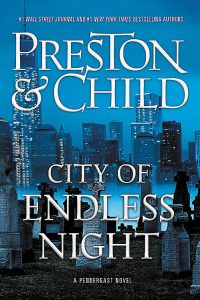After the often credulity-stretching “Obsidian Chamber” (2016), Douglas Preston and Lincoln Child get back on track with “City of Endless Night” (January, hardcover), their 17th Pendergast novel. As the evocative title suggests, the action takes place entirely in their favorite home stomping grounds, New York City, in the winter months when it gets dark early. It’s the most straightforward mystery they’ve penned in a while, although the string of murders are certainly grisly and bizarre enough to be worthy of FBI Agent Pendergast and NYPD detective D’Agosta.
Coming off the very much character-centric “Chamber,” “City of Endless Night” is as much of a standalone as a Pendergast novel can get nowadays. But Pendergast is initially off his game, as D’Agosta observes on page 12:
He was surprised to see the agent not going through his usual rigmarole, with the test tubes and tweezers and loupes appearing out of nowhere and interminable fussing around. He merely walked around the body, almost listlessly. … (Pendergast) didn’t even try to conceal a look of boredom.
As the case gets more intriguing for readers, though, Pendergast is also eventually hooked (although his personal life will come back into play later in the book to reward the series’ loyal fans). Aside from being beheaded, there’s no apparent connection between the victims, and likewise no obvious motive for the killings.
Through the fun character of New York Post reporter Bryce Harriman, P&C introduce the public’s fear of the 1 percent (those who hold the most riches and the best real estate in the Big Apple), probably the most real-world-inspired theme the authors have delved into. We see the inner workings of Harriman’s mind and the Post’s offices, and get a feel for how a tabloid might come up with its stories — while also seeing how a powerful, connected person might influence news content. The authors are still somewhat (endearingly) stuck in the past, as Harriman’s big headlines drive off-the-rack sales records and public opinion.
Reflecting the modern age, though, is Marsden Swope, a blogger who pushes for a new “bonfire of the vanities,” where New Yorkers will throw their most valuable objects into a giant fire and start new, ascetic lives. Honestly, I was kind of encouraged to read about a blogger who gets tons of traffic, but there’s also something odd about the way P&C write Swope’s chapters: It’s all from the activist’s point-of-view, so much so that I wondered if he is so mentally ill that he’s imagining everything.
Psychological illness does come into play when the action moves to a shut-down mental hospital on Long Island, something that finally gives “City of Endless Night” a deliciously old and creepy New York setting in line with the Museum of Natural History that stars in “Relic” and other Pendergast books. I love the idea of the agent digging for clues in a file room that has been abandoned since the state closed down the hospital for its cruel practices toward patients.

Purely as a mystery, “Endless Night” stayed ahead of me yet also let me play the clue-gathering game. I figured out a possible motive before the characters bring it up, but that turns out to be a red herring. The final answer is clever yet simple. The villain ends up being almost supernatural in his skill set, but I suppose that’s necessary in order to stand toe-to-toe with Pendergast.
“Endless Night” has a few sketchily explained elements, such as a subplot about a frame-job on Harriman, but it’s much more grounded than “Obsidian Chamber” overall. Pendergast is still living a life no one can relate to, something most apparent when he enters his second NYC abode for the sake of using the meditation garden within. But while I can’t relate to the FBI agent, I do love reading about him, and I’m glad to find him back to his old tricks.

